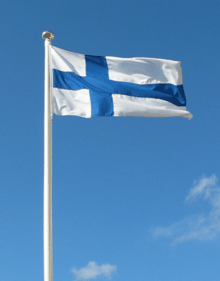Independence Day (Finland)
| Independence Day | |
|---|---|
| Observed by | Finland |
| Significance | The day the Declaration of Independence was adopted by the Parliament of Finland |
| Celebrations | Concerts, Dances |
| Date | 6 December |
| Next time | 6 December 2016 |
| Frequency | annual |
| Related to | Declaration of Independence |
Finland's Independence Day (Finnish: itsenäisyyspäivä, Swedish: självständighetsdagen) is a national public holiday, and a flag day, held on 6 December to celebrate Finland's declaration of independence from the Russian Republic in 1917.
History
The movement for Finland's independence started after the revolutions in Russia, caused by disturbances inside Russia from hardships connected to the First World War. This gave Finland an opportunity to withdraw from Russian rule. After several disagreements between the non-socialists and the social-democrats over who should have the power in Finland, on 4 December 1917, the Senate of Finland, led by Pehr Evind Svinhufvud, finally made a Declaration of Independence which was adopted by the Finnish parliament two days later.
Independence Day was first celebrated in 1917. However, during the first years of independence, 6 December in some parts of Finland was only a minor holiday compared to 16 May, the Whites' day of celebration for prevailing in the Finnish Civil War. The left parties would have wanted to celebrate 15 November, because the people of Finland (represented by parliament) took power 15 November 1917. When a year had passed since declaration of independence, 6 December 1918, the academical people celebrated the day.[1]
Observance
During the early decades of independence, Independence Day was a very solemn occasion marked by patriotic speeches and special church services. From the 1970s onwards, however, Independence Day celebrations have taken livelier forms, with shops decorating their windows in the blue and white of the Finnish flag, and bakeries producing cakes with blue and white icing.[2] Today, rock stars and entertainers have been accepted as worthy interpreters of Finnish patriotism.
It is traditional for Finnish families to light two candles in each window of their home in the evening. This custom dates to the 1920s; but even earlier, candles had been placed in Finnish windows on poet Johan Ludvig Runeberg's birthday as a silent protest against Russian oppression. A popular legend has it that two candles were used as a sign to inform young Finnish men on their way to Sweden and Germany to become jägers that the house was ready to offer shelter and keep them hidden from the Russians.[3]
State festivities
Official Independence Day festivities usually commence with the raising of the Finnish flag on Tähtitorninmäki ("Observatory Hill") in Helsinki. A religious service is held at Helsinki Cathedral, and official visits are made to the war memorials of World War II.
YLE, Finland's national public service broadcaster, broadcasts the movie adaptation of The Unknown Soldier, based on Väinö Linna's iconic novel.[2] In most years, the original 1955 film has been shown (dozens of times) and every year since 2000; but the 1985 version has also been shown once—in 1997.
In the evening, the Presidential Independence Day reception is held for approximately 2000 invited guests at the Presidential Palace. This event, known informally also as Linnanjuhlat ("the Castle Ball"), is broadcast on national television and has been a perennial favourite of the viewing public. The first presidential ball was organized in 1919, and the event has been held most years since.[4]
The reception invariably attracts the attention of demonstrators in support of various causes,[2] and various demonstrations and shadow parties are held to coincide with the official event. The late philanthropist Veikko Hursti organized the most popular of these demonstrations, providing free food to the poor and underprivileged. Since Hursti's death in 2005, the tradition has been carried on by his son, Heikki Hursti.[5]
The most popular television segment of the Independence Day reception is the entrance of the guests. These include persons who receive invitations every year, including the knights of the Mannerheim Cross (traditionally the first ones to enter), members of the government and the Parliament of Finland, archbishops, judges, high military and police officers, and various diplomats and dignitaries. The second group includes guests of the President's own choosing: typically entertainers; activists; sportspersons; and in general, people who have been in the spotlight over the past year. The last guests to enter are always the surviving former Finnish presidents.[6]
90th Anniversary commemorative coin
The 90th Anniversary of Finland's Declaration of Independence was selected as the main motif for a high-value commemorative coin, the €5 90th Anniversary of Finland's Declaration of Independence commemorative coin, minted in 2007. The reverse shows petroglyphic aesthetics, while the obverse has a nine-oar boat with rowers, symbolizing collaboration as a true Finnish trait. Signs of music and Finnish kantele strings can be discerned in the coin's design.
See also
References
- ↑ Kolbe, Laura (2011). "Linnan juhlia vuodesta 1919". Tiede (in Finnish). Retrieved 2016-04-29.
- 1 2 3 Snyder, Russell (2011). "Finns celebrate freedom every December". Finland. Retrieved 2016-04-29.
- ↑ "Gunwriters". P. T. Kekkonen. Retrieved 12 May 2006.
- ↑ "History of the Independence Day reception at the Presidential Palace". The Office of the President of the Republic of Finland. Retrieved 7 June 2008.
- ↑ "Finnish Independence Day". Yle. 2012. Retrieved 2016-04-29.
- ↑ Rautiainen, Riitta (2004). "The President's Independence Day Reception". University of Tampere. Retrieved 2016-04-29.
External links
![]() Media related to Independence Day (Finland) at Wikimedia Commons
Media related to Independence Day (Finland) at Wikimedia Commons
